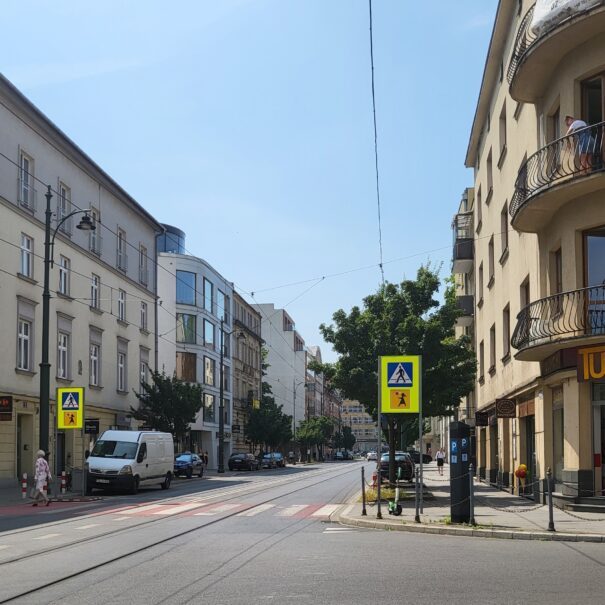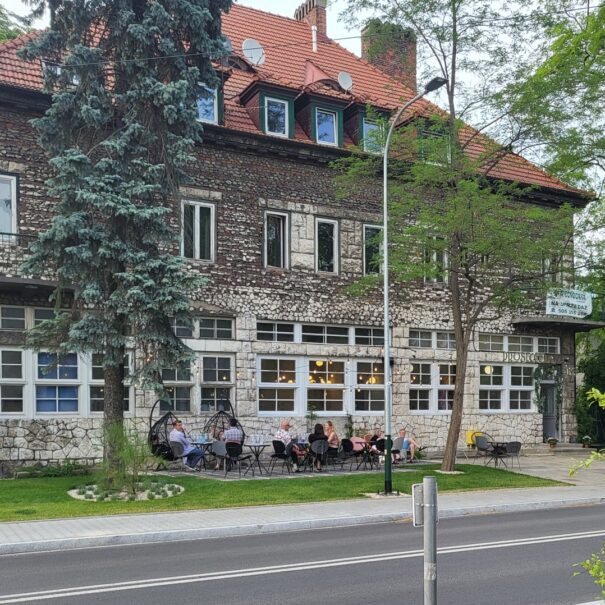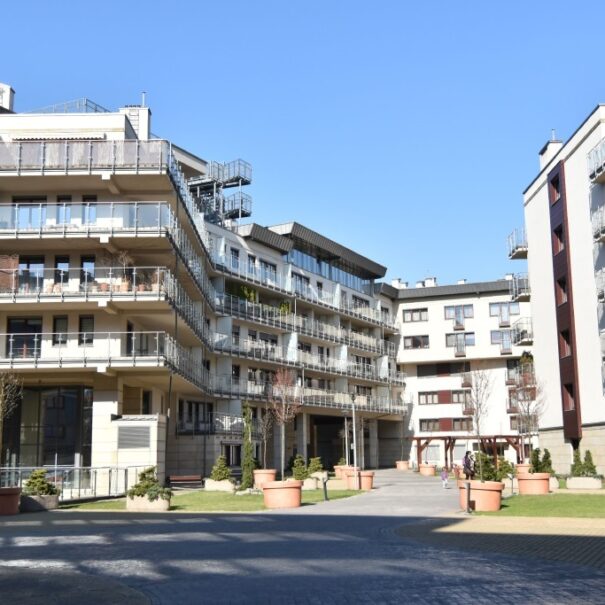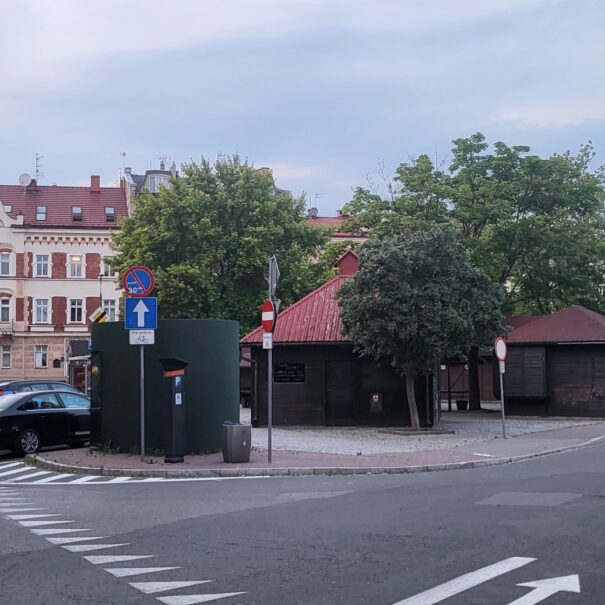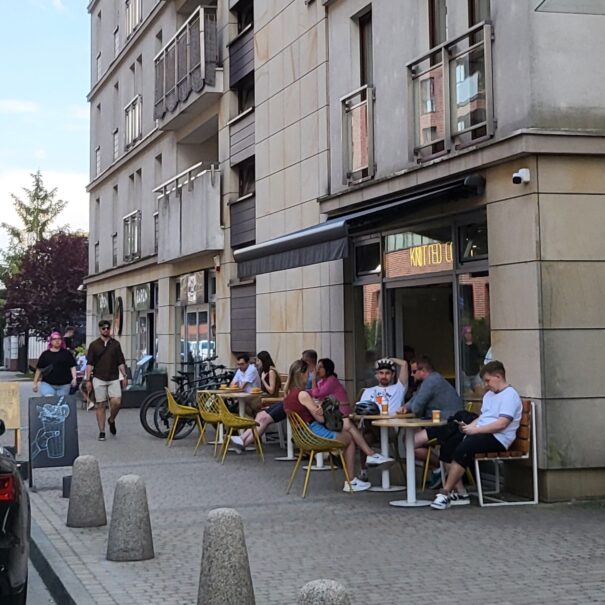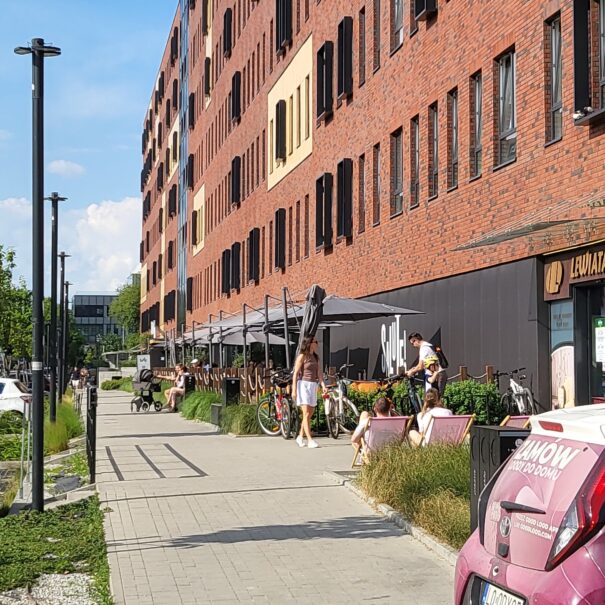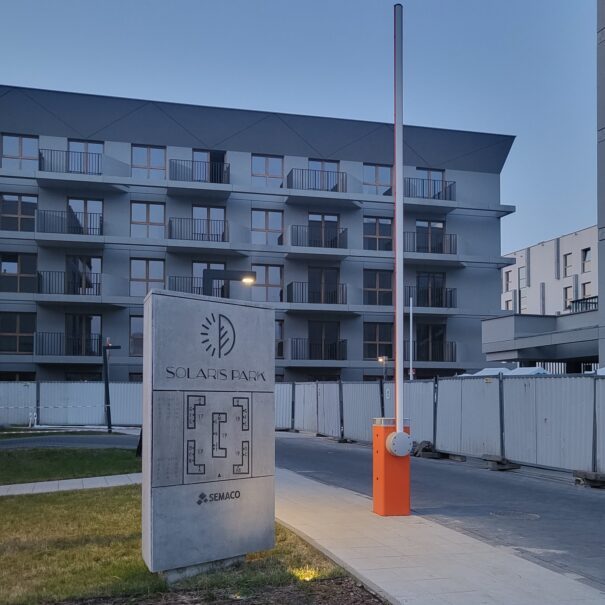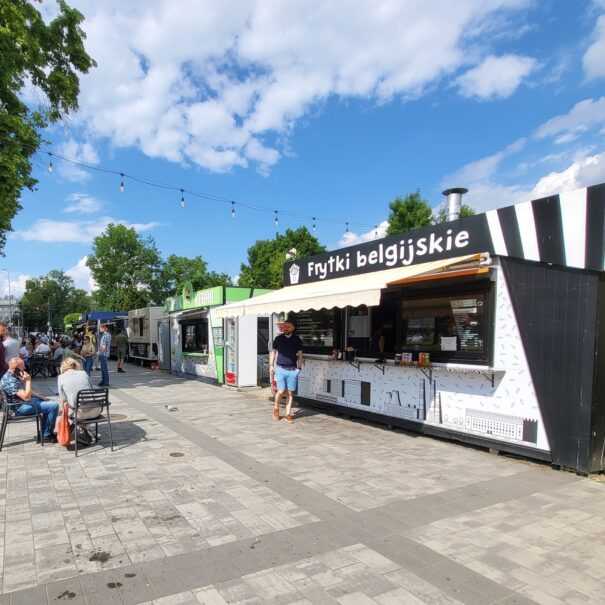Planning an extended or long-term stay in Krakow involves finding a neighbourhood that suits your needs, preferences and budget. This guide aims to provide practical information to help you navigate Krakow’s districts.
From proximity to amenities and transportation links to local attractions and residential vibes, we’ll get into the details that will help you make an informed decision on where to live.
Krakow’s 18 districts
The city of Krakow is composed of 18 administrative districts. Each district has its own name as well as a Roman numeral. The whole urban area is divided by the Vistula River, with 12 districts located on the north side of the river, and 6 on the south side. In this guide, we will examine the pros and cons of each area.
Average long-term rents
For each district, we will quote the average long-term rent that you can expect to pay for a one-room studio or two-room apartment. These figures are taken from morizon.pl, a Polish property search engine, and they are up-to-date at the time of writing (though we will update them from time to time).
However, it’s important to remember that they may not reflect the actual amount that you will have to pay, as landlords often quote monthly rent without an extra charge known as ‘czynsz’ in Polish. This czynsz is a fixed extra fee that covers additional expenses such as building maintenance, rubbish removal/disposal and property management. If you’re looking at a rental, make sure to check all the details.
Scroll down or click on the map to read about each district.

Stare Miasto (I)
The Stare Miasto district offers a central location with convenient access to many attractions, including the famous Main Market Square, the St. Mary’s Basilica and the Royal Wawel Castle. The district features museums, art galleries, theatres, cafes, bars, restaurants and clubs, making it a hub of cultural activity. Its central location also provides excellent accessibility to other parts of Krakow.
The district is characterised by mainly 19th century tenement buildings, and it includes the historic Kraków Old Town, surrounded by the famous Planty Park, the former Jewish quarter of Kazimierz, as well as and a number of other neighbourhoods such as Kleparz, Stradom and Piasek. Despite belonging to the same administrative district, we will look at these areas separately as they each have their own distinctive character and suit different preferences.
Average long-term rents
1-room flat/studio: 2 500 zł (87 zł/m²)
2-room flat: 3 538 zł (72 zł/m²)
Krakow Old Town
Staying in the heart of the historical city means being right by the famous Main Market Square and the surrounding cafes, restaurants, nightlife venues and other tourist attractions. It is largely a pedestrian area with cobbled streets and picturesque architecture. Unsurprisingly, long-term rents here are among the highest in the city.
Pros
- right in the heart of the historic city centre
- cosy vibe during the day, lively ambiance at night
- close to hundreds of cafes, restaurants, bars, night life venues
- walking distance to main tourist attractions
- good shopping options nearby (e.g. Galeria Krakowska shopping centre)
Cons
- most expensive accommodation
- crowds of tourists during the high season
- can get noisy at night
- difficult for men to walk around alone in the evening without being bothered by strip club promoters
- high winter heating bills due to old buildings
- for drivers, not many places to park
Kazimierz
Kazimierz, the Jewish Quarter, is known for its artistic and bohemian vibes. This popular neighbourhood offers a unique blend of Jewish heritage, trendy bars and cool cafes. Accommodation is relatively expensive, though not quite as expensive as in the Krakow Old Town.
Pros
- close to cafes, restaurants and bars
- more trendy and less touristy vibes than the Krakow Old Town
- good shopping options (e.g. the Plac Nowy market)
Cons
- expensive accommodation
- high winter heating bills due to old buildings
Kleparz
Kleparz is located north of the Krakow Old Town. Thanks to its location, residents can easily enjoy the city’s most famous landmarks, but at the same time avoid the crowds of tourists, noise and other minor inconveniences. The area features small clothing shops, fitness centres, bistros and the lively Stary Kleparz market, where you can buy fresh local produce. It’s also home to Krakow’s main train and bus station, as well as the Galeria Krakowska shopping centre.
Pros
- not far from the main attractions
- excellent transport connections
- a few modern residential buildings (e.g. Angel City)
- away from the crowds of tourists in the Krakow Old Town
- good for shopping and groceries
Cons
- relatively expensive accommodation options
- high winter heating bills in old buildings
Stradom
The Stradom neighbourhood is sandwiched between Kazimierz and the Krakow Old Town. This makes it a very convenient central location, within a short walking distance of all the main landmarks and attractions, but without being right in the heart of the action. The area boasts picturesque architecture, a few green spaces and a number of small shops and cafes.
Pros
- convenient location between Krakow Old Town and Kazimierz
- just away from the crowds of tourists
- shops and cafes nearby
Cons
- expensive accommodation
- high winter heating bills due to old buildings
Piasek
The Piasek neighbourhood is situated just to west of the Krakow Old Town. It is divided in two by the busy Karmelicka Street, where the famous Bagatela Theatre is situated. Many residents choose to live in its quiet side streets, which offer a central location and convenient access to local shops, cafes, restaurants and other attractions.
Pros
- central location without being in the heart of the action
- away from the crowds of tourists
- good shopping options
Cons
- expensive accommodation options
- high winter heating bills due to old buildings
Grzegórzki (II)
The Grzegórzki district, located just east of the Old Town centre, provides a more student-friendly and laid-back atmosphere than the Stare Miasto. The area is well-connected to the rest of the city through public transportation, with plenty of tram and bus lines serving the area. This makes it easy to explore other parts of Krakow.
In terms of amenities, Grzegórzki boasts a variety of shops and supermarkets, including the Galeria Kazimierz shopping centre, as well as local markets, such as the Hala Targowa open-air market. There are also several parks and green spaces where you can relax and go for a peaceful walk.
The area is characterised by a variety of housing types and architecture, including Communist-era buildings, a few new developments such as on Masarska Street (near Galeria Kazimierz) and picturesque old buildings in the centrally-located historic Wesoła neighbourhood. Unsurprisingly, rental rates will vary depending on the building type.
Average long-term rents
1-room flat/studio: 2 552 zł (75 zł/m²)
2-room flat: 3 311 zł (73 zł/m²)
Pros
- well connected to the Old Town, Kazimierz and rest of the city
- good shopping options
- more budget-friendly than Stare Miasto
- good options for dining and coffee in the more centrally-located parts
Cons
- not many cafes, bars and restaurants in the more distant parts of the district
- accommodation more expensive on the west side
- many bland Communist-era buildings in the southern and eastern parts of the district
Prądnik Czerwony (III)
Prądnik Czerwony is a neighbourhood known for its affordable residential areas, comprising of different types of properties, including low and high rise buildings from the 1970s and 1980s, single family houses and modern developments. Located in the northern part of Krakow, it offers a peaceful and family-friendly living environment. It is mainly a residential district, but there are a few tourist attractions such as Krakow Fortress, the Tourist and Cultural Route and the Małopolska Way of St. Jacob.
With its well-maintained streets, green spaces, and a range of amenities such as schools, parks and playgrounds for children, Prądnik Czerwony provides a safe, welcoming atmosphere for family-oriented residents and first-time home buyers.
Average long-term rents
1-room flat/studio: 2 005 zł (72 zł/m²)
2-room flat: 2 199 zł (58 zł/m²)
Pros
- more affordable modern apartments
- well-maintained streets
- some picturesque green areas
- good parking options
Cons
- limited public transport connections (no tram routes)
- limited entertainment options
- 20-25 minutes by car with traffic to the Old Town
Prądnik Biały (IV)
Prądnik Biały is a large dynamically developing area that combines affordable suburban living with access to nature. Situated in the northern part of Krakow, where the city meets the countryside, it offers a peaceful and scenic environment. The southern part of the neighbourhood features a busy retail area that includes the Galeria Bronowice shopping centre and an IKEA store. Staying in Prądnik Biały offers budget-friendly suburban living among natural surroundings such as the Dolina Prądnika nature reserve, where you can go for a relaxing walk along the Białucha River.
Average long-term rents
1-room flat/studio: 1 962 zł (73 zł/m²)
2-room flat: 2 561 zł (59 zł/m²)
Pros
- affordable accommodation
- more budget-friendly prices
- peaceful, natural surroundings
- good parking options
Cons
- 5-6km to the Old Town centre (40 minutes by car with traffic)
- lack of attractions and entertainment
Krowodza (V)
The Krowodza district is a student-friendly neighbourhood with an excellent location, especially for those studying at the AGH University of Science and Technology, as the main building, the campuses and the halls of residence are located there. It is conveniently close to the Old Town centre, which is within 20 minutes’ walk from the more central part of the district. The area is also well connected with other parts of the city, as most trams and buses stop there.
For those who like green spaces, Krowodza is also very close to Blonia Meadow, Jordan Park and Krakowski Park, popular areas with runners, cyclists and rollerbladers. And the numerous small cafes, shops and restaurants dispersed all over the area offer some local options for eating, drinking and shopping.
Average long-term rents
1-room flat/studio: 2 090 zł (76 zł/m²)
2-room flat: 2 891 zł (64 zł/m²)
Pros
- more affordable than the Old Town centre
- lots of green spaces for walking, biking and running
- good transport connections
- convenient location for AGH students
Cons
- some of the roads are not well-maintained
- many of the old buildings lack character
Bronowice (VI)
Bronowice is a relatively affordable district that is well connected to the city centre by public transport. The area features a variety of housing types from low-rise blocks built in the 1950s, in the older part of the district closer to the centre, to single family houses and more modern developments further away from the centre. Like most residential areas, you can find shops, restaurants, cafes and gyms.
Average long-term rents
1-room flat/studio: 1 963 zł (66 zł/m²)
2-room flat: 2 734 zł (62 zł/m²)
Pros
- more affordable accommodation than the city centre
- excellent bus and tram connections to the centre and other parts of the city
- quiet district
Cons
- lack of attractions and entertainment
- some of the roads are not well-maintained
- bland residential buildings in the older part of the district
Zwierzyniec (VII)
Zwierzyniec is a clean, safe and affluent neighbourhood that combines urban living with beautiful natural surroundings. Situated in the western part of Krakow, it is known for its green spaces like the expansive Wolski Forest, as well as the popular Krakow zoo, the Błonia Meadow, a favourite with runners and cyclists, and the Kościuszko Mound, a man-made hill that overlooks the river nearby.
Its most well-known neighbourhood, Wola Justowska, is regarded as the most prestigious suburb of Krakow. It is the city’s most expensive residential suburb and is home to many of Krakow’s wealthiest residents, who live in its stylish low-rise residential buildings, detached houses and villas.
Average long-term rents
1-room flat/studio: 2 000 zł (65 zł/m²)
2-room flat: 3 292 zł (73 zł/m²)
Pros
- no high-rise buildings
- clean, peaceful, exclusive surroundings
- green spaces for walking, biking and running
- not far from Krakow Airport
- well-connected to the centre by road
Cons
- accommodation can be expensive
- no tram routes (though this is part of the area’s exclusivity)
- some parts lack local cafes, restaurants and shops (it helps to have a car)
Dębniki (VIII)
Dębniki is a large district located west of the city centre. It offers a mix of residential areas, commercial areas and green spaces such as the Tynieckie Forest. The district extends to the edge of the city, but the Dębniki and Ludwinów neighbourhoods, situated close to the Vistula River, are considered the most desirable. These areas provide opportunities for scenic walks and outdoor activities, and they are well-connected to the city centre and other parts of Krakow.
Average long-term rents
1-room flat/studio: 2 137 zł (74 zł/m²)
2-room flat: 2 734 zł (60 zł/m²)
Pros
- some high-standard modern residential buildings
- well-connected to the centre
- away from crowds of tourists
- opportunities for scenic riverside walks
Cons
- renting a flat in the most desirable developments may be expensive
Podgórze (XIII)
The Podgórze district is located across the Vistula River from the Kazimierz and Grzegorzki neighbourhoods. As the former Krakow Ghetto, it has a dark history and was quite run-down until a few years ago. Today, it has been transformed into one the city’s most interesting and liveable areas, with numerous fine dining restaurants, trendy cafes and riverside bars. The most interesting and accessible parts of the district are the Stare Podgorze and Zablocie neighbourhoods. These areas feature a number of high standard modern developments, providing a modern urban living environment that is laid-back and well connected to the centre.
Average long-term rents
1-room flat/studio: 2 945 zł (71 zł/m²)
2-room flat: 2 734 zł (60 zł/m²)
Pros
- some modern residential buildings
- well-connected to the city centre
- away from crowds of tourists
- trendy and laid-back vibes
- opportunities for scenic riverside walks
Cons
- accommodation in modern developments may be expensive
Łagiewniki-Borek Fałęcki (IX), Swoszowice (X), Podgórze Duchackie (XI), Bieżanów-Prokocim (XII)
These lesser-known districts, located south of the Vistula River, are characterised by diverse residential buildings, from low-rise older buildings to private villas and modern developments offering new apartments with balconies. Since many parts of these areas are not well-connected to the centre (it helps to have a car) and are not known for being places of interest, prices are lower than average. Within each district, you will find a mix of neighbourhoods, some more desirable that others, but if you are just looking for a modern apartment in a new building and don’t mind the distance to the city centre, you might be able to find a bargain in these parts.
Average long-term rents
1-room flat/studio: 1 882 zł (62 zł/m²)
2-room flat: 2 431 zł (58 zł/m²)
Pros
- more affordable accommodation
- quiet districts
- green spaces
Cons
- difficult to reach the centre from many parts of these districts
- limited local attractions
- some neighbourhoods are to be avoided at night
Czyżyny (XIV)
This mainly residential district is located between Grzegorzki and up-and-coming Nowa Huta. Although it is 5km from the Krakow Old Town, it does feature a number of lesser-known attractions such as the Polish Airmen Park, Tauron Arena (where many concerts and events are held), as well as numerous monuments, cultural institutions and green areas for walking and biking. The M1 shopping centre is also located here.
The area includes many new modern developments as well as Communist-era blocks, and apartments are relatively affordable to rent.
Average long-term rents
1-room flat/studio: 2 122 zł (62 zł/m²)
2-room flat: 2 610 zł (61 zł/m²)
Pros
- more affordable accommodation
- new residential buildings in the more desirable parts
- well-connected to the centre via the Krakow ring road
- lots of green spaces
Cons
- lacks the up-and-coming vibe of its Nowa Huta sibling district (although interesting development projects are underway)
- many bland Communist-era buildings in older parts of the district
Mistrzejowice (XV), Bieńczyce (XVI), Wzgórza Krzesławickie (XVII)
These districts are located in the north of the city, between the districts of Prądnik Czerwony and Nowa Huta. They are characterised by large housing estates, with new apartments being built all the time. Mistrzejowice and Bieńczyce feature mainly high-rise buildings whereas Wzgórze Krzesławickie, which is located on a hill (“wzgórza” means hill in Polish), offers mainly low-rise housing.
Average long-term rents
1-room flat/studio: 1 995 zł (63 zł/m²)
2-room flat: 2 378 zł (58 zł/m²)
Pros
- affordable areas
- some modern housing
- lots of green spaces
- free parking
Cons
- far from the centre and many parts are not well-connected
- lots of Communist-era housing estates
- high density of tall buildings in many neighbourhoods
- lack of local attractions
Nowa Huta (XVIII)
Whereas the Krakow Old Town features cobbled streets, picturesque architecture and crowds of tourists, Nowa Huta is the total opposite. This concrete suburb is like to travelling back in time to the communist era in Poland with its socialist realism architecture. However, in recent years it has emerged as a laid-back and trendy area, full of green spaces and well connected to the centre by road and public transport. What’s more, it is no longer considered a depressing and dangerous district to be avoided.
Average long-term rents
1-room flat/studio: 1 853 zł (63 zł/m²)
2-room flat: 2 428 zł (56 zł/m²)
Pros
- still relatively affordable
- well-connected to the city centre by public transport
- up-and-coming area
- lots of large green spaces
Cons
- despite good transport connections, the district is 10km from the centre
- Communist-style architecture is not to everybody’s liking
So many choices, which area to choose?
It all depends on your preferences and budget. Let’s break it down.
You want to live in a lively area, within close proximity to popular bars, cafes, restaurants, nightlife venues and other tourist attractions? You are okay with living in an old building? Explore your options in the Stare Miasto district if you have a fairly healthy budget or the Wesola neighbourhood of the Grzegórzki district.
You prefer to be in in a trendy area away from the most touristy parts of city? You want to be close enough to the centre but don’t want to live in an old building? Check out Podgorze or Dębniki.
You want to be close to nature? Explore Zwierzyniec, if you have the budget, or somewhere like Pradnik Bialy if you don’t mind living on the outskirts of the city and if you have a car (preferably).
You have a tight budget and you don’t mind taking an easy tram ride to the city centre? Try Grzegorzki, Krowodza or even Bronowice.
You’re a student at the AGH University or you want to be in a student-friendly area? Krowodza might be the district for you.
You want to live in an affordable family-friendly suburb and you don’t mind being away from all the attractions in the centre? Pradnik Czerwony or Czyżyny might work for you.
You like the idea of living in a budget-friendly, emerging area and you don’t mind being 10km outside the centre? Nowa Huta might appeal to you.
It’s important to remember that some of the larger districts in this guide include some less desirable streets and neighbourhoods, so make sure to explore the surrounding area properly if you’re considering an accommodation option.
It’s a good idea to take a few weeks to explore your options before deciding on a long-term place of residence. It helps to book short or medium-term accommodation while you visit different neighbourhoods. Online rental portals may offer favourable rates. Alternatively, you can book a medium-term rental with us, if you don’t mind being outside the centre for a while.











